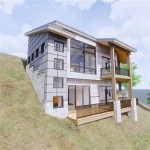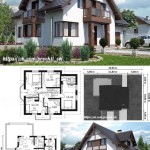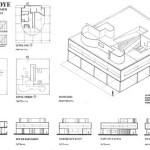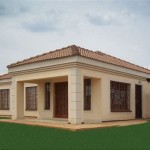4 Bedroom House Plans In Kerala Double Floor: A Comprehensive Guide
Kerala, known for its lush greenery and rich cultural heritage, also boasts a unique architectural style that blends tradition with modernity. The demand for 4 bedroom double floor houses in Kerala is consistently high, driven by the needs of growing families and the desire for spacious living. These homes offer a balance of functionality and aesthetics, incorporating features that are well-suited to the tropical climate and lifestyle of the region. Understanding the key considerations and design elements involved in planning such a house is crucial for prospective homeowners.
This article provides a detailed overview of 4 bedroom double floor house plans in Kerala, covering essential aspects such as space planning, architectural styles, material selection, cost considerations, and compliance with local regulations. The aim is to equip readers with the knowledge necessary to make informed decisions throughout the design and construction process.
Key Considerations for Planning a 4 Bedroom Double Floor House in Kerala
Several factors must be carefully considered before finalizing a 4 bedroom double floor house plan in Kerala. These considerations directly impact the overall functionality, comfort, and cost-effectiveness of the project. Ignoring these aspects can lead to dissatisfaction and costly modifications later on.
1. Site Analysis and Orientation: The characteristics of the building site, including its dimensions, topography, soil type, and orientation, play a pivotal role in determining the optimal house plan. The orientation of the house relative to the sun is particularly important in Kerala's tropical climate. Proper orientation can minimize heat gain during the day and maximize natural ventilation, reducing the need for artificial cooling. A thorough site analysis should also identify potential challenges such as waterlogging or soil instability, allowing for appropriate mitigation measures to be incorporated into the design.
2. Family Needs and Lifestyle: The house plan should reflect the specific needs and lifestyle of the family who will be living in it. Consider the number of family members, their ages, and their individual requirements. For instance, if there are elderly individuals in the family, it is important to incorporate features such as ramps or elevators to ensure accessibility. The layout should also accommodate the family's preferred activities and hobbies. Do they require a home office, a dedicated space for prayer, or a large kitchen for entertaining? These factors should be carefully considered during the planning stage.
3. Budget Constraints: Establishing a realistic budget is crucial for a successful house construction project. The cost of construction can vary significantly depending on the materials used, the complexity of the design, and the prevailing labor rates. It is advisable to consult with an experienced architect or contractor to obtain a detailed cost estimate before commencing the design process. The budget should also include contingency funds to cover unexpected expenses or changes in material prices.
Architectural Styles Commonly Used in Kerala Double Floor Houses
Kerala's architectural landscape is characterized by a blend of traditional and modern styles. Several architectural styles are commonly employed in 4 bedroom double floor house plans, each with its own unique characteristics and aesthetic appeal.
1. Traditional Kerala Style: This style is characterized by its sloping roofs, courtyards (nadumuttam), and use of locally sourced materials such as wood and laterite stone. The traditional Kerala house is designed to be naturally cool and well-ventilated, making it well-suited to the climate. Features such as the verandah (poomukham) and the charupadi (a sloping seat along the verandah) provide comfortable outdoor spaces for relaxation and interaction.
2. Contemporary Style: Contemporary house designs in Kerala often incorporate clean lines, minimalist aesthetics, and large windows to maximize natural light. These designs may also feature open-plan living spaces and modern amenities. While contemporary designs may incorporate elements of traditional Kerala architecture, they typically prioritize functionality and ease of maintenance.
3. Colonial Style: Inspired by the colonial era, this style often features grand entrances, large verandas, and symmetrical layouts. Colonial-style houses may incorporate elements of both European and Indian architecture, creating a unique and elegant aesthetic. These houses often utilize materials such as stucco, brick, and tile.
4. Fusion Style: Many homeowners opt for a fusion style that blends elements of different architectural traditions. This approach allows for a customized design that reflects the homeowner's personal preferences. A fusion style house may incorporate traditional Kerala elements such as sloping roofs and courtyards, while also incorporating modern features such as large windows and open-plan living spaces.
Essential Components of a 4 Bedroom Double Floor House Plan
A well-designed 4 bedroom double floor house plan should incorporate several essential components to ensure functionality, comfort, and aesthetic appeal. These components include the layout of the rooms, the placement of windows and doors, and the integration of essential services such as plumbing and electrical systems.
1. Ground Floor Layout: The ground floor typically includes the living room, dining room, kitchen, one or two bedrooms (often for guests or elderly family members), and a utility room. The living room should be spacious and well-lit, providing a comfortable space for relaxation and entertainment. The dining room should be conveniently located near the kitchen. The kitchen should be designed to be functional and efficient, with ample storage space and appropriate ventilation. It is becoming increasingly common to incorporate open-plan layouts which combine the living, dining and kitchen areas to maximize space and create a more social atmosphere.
2. First Floor Layout: The first floor typically includes the remaining bedrooms, a family room or lounge area, and balconies. The master bedroom should be spacious and include an attached bathroom and dressing area. The other bedrooms should be adequately sized and well-ventilated. A family room or lounge area provides a comfortable space for family members to relax and interact. Balconies offer outdoor spaces for enjoying the views and fresh air.
3. Staircase Design: The staircase is an important design element that connects the two floors. The staircase should be aesthetically pleasing and easy to navigate. The design should also comply with safety regulations. Common staircase designs in Kerala houses include straight staircases, L-shaped staircases, and spiral staircases.
4. Bathroom and Toilet Placement: Bathrooms and toilets should be conveniently located and well-ventilated. Each bedroom should ideally have an attached bathroom. Common bathroom fixtures include a shower, toilet, and washbasin. Modern bathrooms may also include features such as bathtubs and Jacuzzis.
5. Kitchen Design and Appliances: The kitchen is a central area of the home and should be designed for efficiency and convenience. A modular kitchen design is a popular choice, offering ample storage and workspace. Essential kitchen appliances include a refrigerator, stove, oven, and microwave. Proper ventilation is essential to prevent the buildup of odors and moisture.
6. Landscaping and Outdoor Spaces: The landscaping and outdoor spaces surrounding the house contribute significantly to its overall aesthetic appeal and functionality. A well-designed garden can provide a relaxing and enjoyable outdoor space for the family. Common landscaping elements in Kerala houses include lawns, flower beds, and trees. Outdoor spaces may also include a patio or deck for outdoor dining and entertaining.
Material Selection and Sustainable Building Practices
The choice of building materials has a significant impact on the structural integrity, energy efficiency, and aesthetic appeal of a house. Sustainable building practices are becoming increasingly important, both for environmental reasons and for long-term cost savings.
1. Locally Sourced Materials: Using locally sourced materials can reduce transportation costs and support the local economy. Common locally sourced materials in Kerala include wood, laterite stone, and clay tiles. Utilizing these materials contributes to the authentic Kerala architectural style.
2. Energy-Efficient Materials: Selecting energy-efficient materials can reduce the energy consumption of the house and lower utility bills. Examples of energy-efficient materials include insulated concrete forms (ICF), double-glazed windows, and reflective roofing materials.
3. Sustainable Building Practices: Sustainable building practices aim to minimize the environmental impact of construction and reduce the long-term operating costs of the house. Examples of sustainable building practices include rainwater harvesting, solar panel installation, and the use of recycled materials.
4. Roofing Materials: Roofing materials should be durable, weather-resistant, and aesthetically pleasing. Common roofing materials in Kerala include clay tiles, concrete tiles, and metal sheets. The choice of roofing material depends on the architectural style of the house and the homeowner's preferences.
Cost Considerations and Budgeting for a 4 Bedroom Double Floor House in Kerala
The cost of constructing a 4 bedroom double floor house in Kerala can vary significantly depending on several factors, including the size of the house, the materials used, the complexity of the design, and the prevailing labor rates. Developing a realistic budget is essential for a successful project.
1. Construction Costs: Construction costs typically account for the largest portion of the overall budget. These costs include the cost of materials, labor, and equipment. It is advisable to obtain several quotes from different contractors to ensure competitive pricing.
2. Design and Planning Costs: Design and planning costs include the fees charged by architects, engineers, and other consultants. These fees can vary depending on the complexity of the project and the level of service provided.
3. Landscaping and Outdoor Costs: Landscaping and outdoor costs can add significantly to the overall budget. These costs include the cost of plants, soil, and labor. Consider incorporating low-maintenance landscaping options to reduce long-term maintenance costs.
4. Contingency Funds: It is essential to include contingency funds in the budget to cover unexpected expenses or changes in material prices. A contingency fund of 5-10% of the total budget is generally recommended.
5. Interior Design Costs: The costs associated with interior design, including furniture, fixtures, and accessories, can vary widely depending on individual preferences and the level of customization desired. Setting a clear budget for interior design is crucial to avoid overspending.

4 Bedrooms Double Floor Kerala Home Design 1820 Sq Ft Bedroom 2 House Plan Be Plans

4 Bedroom Latest Model Home Design With Inside Courtyard In Kerala Traditional Wit N House Plans Free

Kerala Style Double Y House Plans Under 1600 Sq Ft For 5 Cent Plots Small Hub

Simple 4 Bedroom Two Story Kerala Style House Plan Home Planners

4 Bedroom Small Plot Home Design With Free Plan Kerala Plans House Layout Modern

Five Bedroom Kerala Style Two Y House Plans Under 3000 Sq Ft 4 Small Hub

4 Bedroom House Plan Double Floor With Four Bedrooms Attach Toilet

4 Bedroom Beautiful Kerala Home Design In 1871 Sq Ft With Free Plan Plans House Houses Bungalow Floor

Beautiful Double Floor House In Calicut 2 Acha Homes

4 Bedroom House Plans Free Double Story Nethouseplans Nethouseplansnethouseplans








